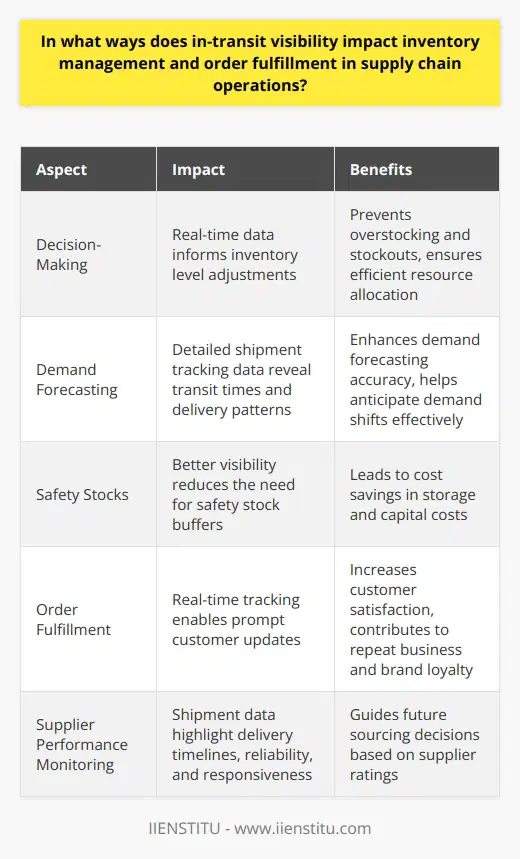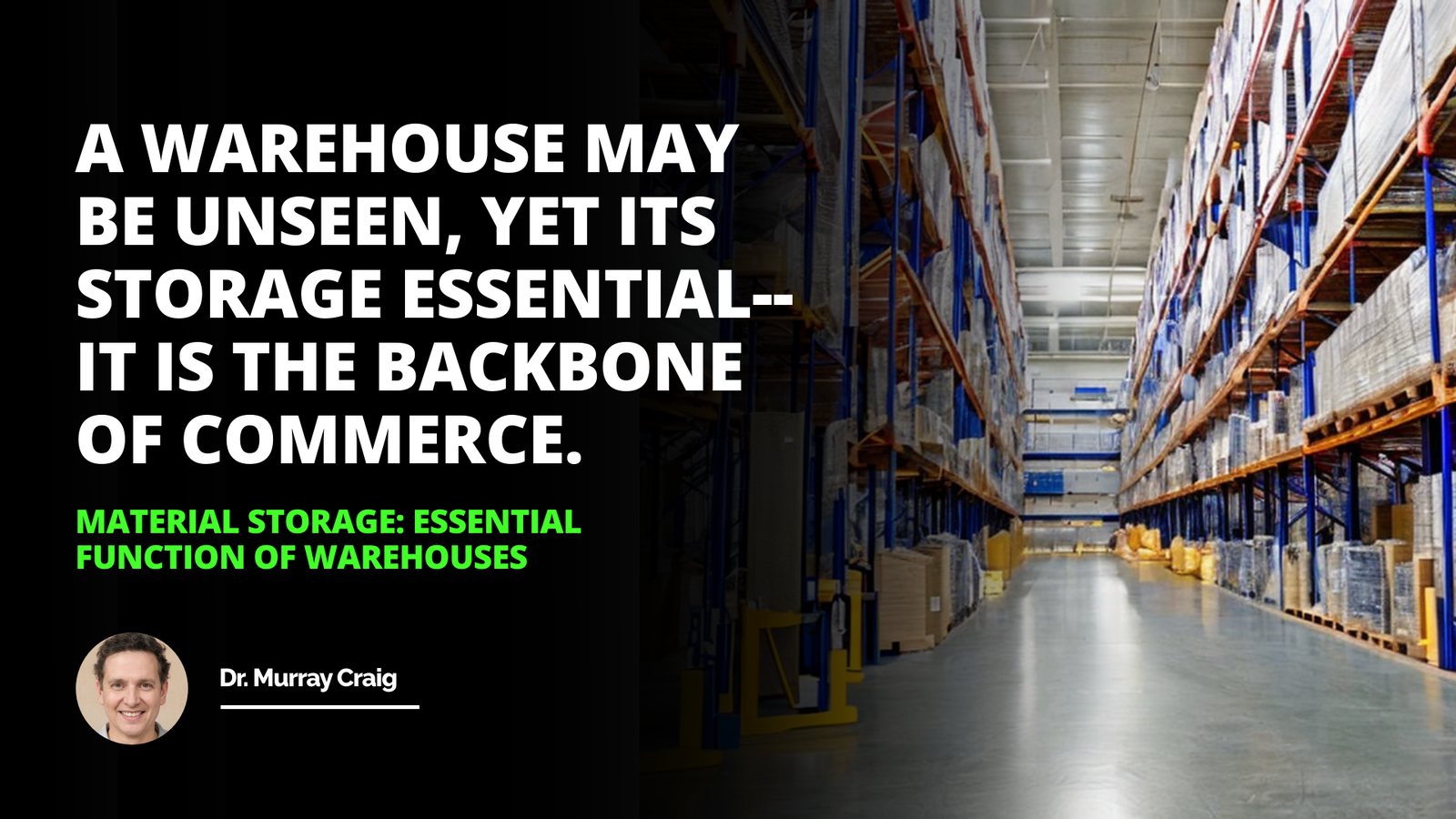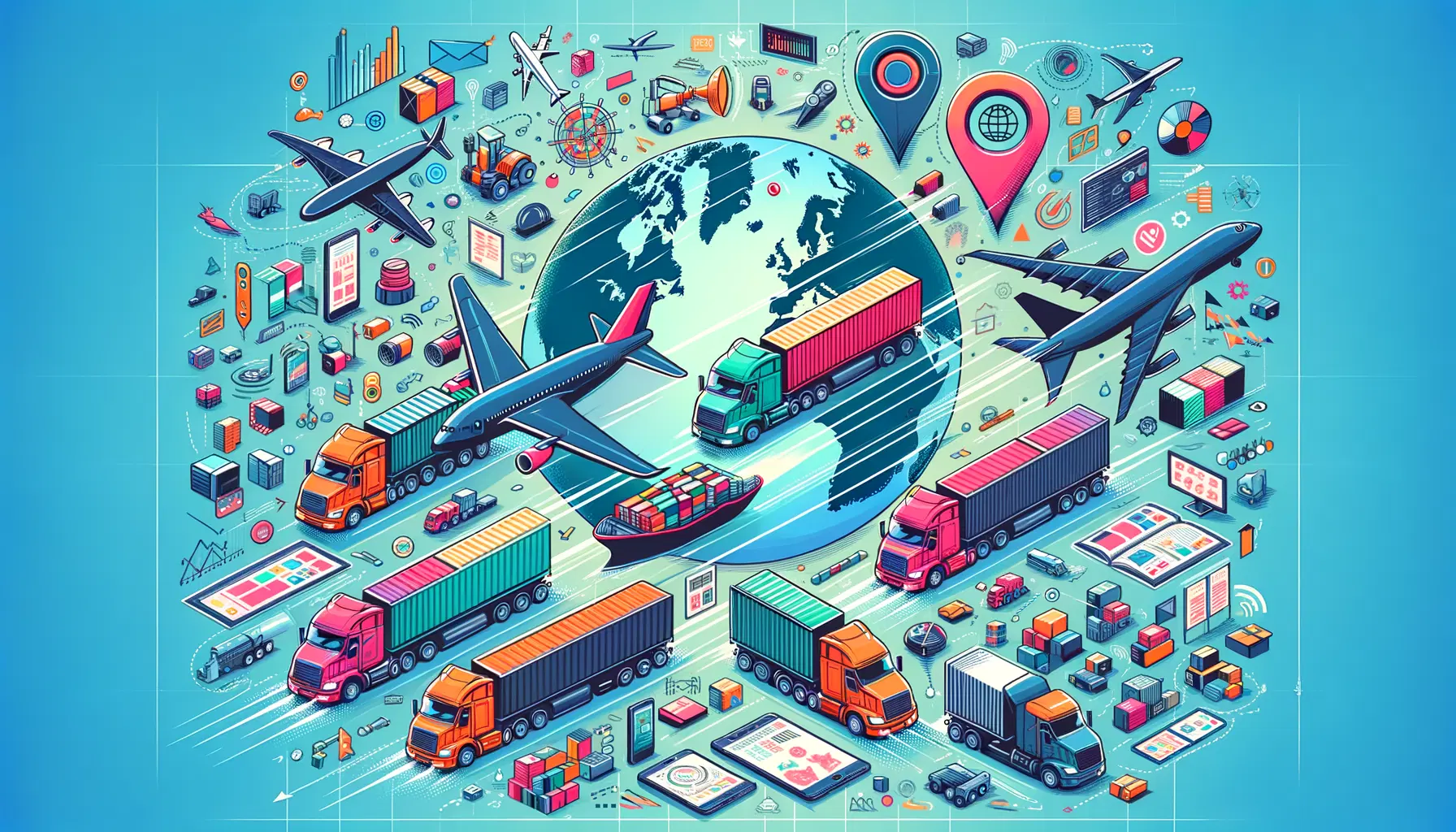
In the intricate web of modern logistics and supply chain management, in-transit visibility is a term that has gained immense prominence.
Understanding where products are at any given moment not only provides peace of mind but also equips businesses with the crucial data to optimize their supply chain operations. It signifies a paramount function in contemporary logistics practices, intertwining technology with procedural precision to enhance the reliability and efficiency of product deliveries.
This article will dissect the nuances of in-transit visibility, exploring its definition, importance, and the inherent imperative of its use in the supply chain and logistic management course content.
Definition of In-Transit Visibility
In-transit visibility is the capability to track and monitor the status and location of goods as they move from origin to destination.
This involves the collection and analysis of data throughout the supply chain journey, providing stakeholders with up-to-date information about their assets.
Such visibility is crucial for accurately forecasting arrival times and proactively managing any discrepancies that may arise during transit.
Importance of In-Transit Visibility in logistics and supply chain
In the world of logistic management, in-transit visibility stands as a cornerstone, enabling companies to maintain control over their operations outside the warehouse or factory.
From reducing inventory carrying costs to improving customer satisfaction, its importance cannot be overstated. In an age where consumer expectations are at an all-time high, delivering this data transparency is not just beneficial; it is expected.
Brief overview of In-transit visibility
In-transit visibility is not a standalone concept but an integration of various systems and technologies. In this overview, we shall touch on the layers and components that comprise this aspect of supply chain management, which involves processes and tools ranging from simple barcode scanning to sophisticated real-time tracking devices.
This overview sets the stage for a more in-depth exploration in the following sections.
Understanding In-Transit Visibility
At its core, in-transit visibility is about gaining clarity and control over the journey of goods. This concept has evolved significantly over the years, largely due to advancements in technology. Let's delve further into its components.
What is In-Transit Visibility?
In-transit visibility is the real-time analysis of freight transport, providing granular details on shipment location and condition. Unlike traditional tracking methods, which offered only snapshots of a shipment's journey, in-transit visibility provides a dynamic portrait of the goods' movement, empowering businesses to make informed decisions and adjust operations on the fly.
Simple explanation
Even for the uninitiated, the concept can be approachable; consider it akin to tracking a parcel you order online, but on a vastly more complex scale. Businesses leverage in-transit visibility to supervise an array of products across different routes, carriers, and international borders.
How it differs from other types of visibility
Traditional methods focus on pre-shipment and post-shipment visibility, neglecting the critical in-transit phase. In contrast, in-transit visibility fills this gap, offering continuous insights during one of the most vulnerable stages of the supply chain.
Key elements of In-Transit Visibility
A robust in-transit visibility system hinges on several key components. These elements work in harmony to provide an accurate portrayal of a shipment's journey.
Real-time tracking
At the forefront is real-time tracking. Utilizing an array of sensors and tracking devices, companies can acquire live updates on their shipments, translating into proactive supply chain management.
Data integration
Data integration is fundamental; disparate data sources must be consolidated to provide a cohesive view. This allows different stakeholders to interpret and utilize the information most relevant to them.
Cross-functional collaboration
Moreover, cross-functional collaboration is intensified; in-transit visibility breaks down informational silos, fostering better communication and coordination among departments.
The role of technology in In-Transit Visibility
Technology is the backbone of modern in-transit visibility systems. Without it, achieving the granularity and immediacy of data required for real-time visibility would be impossible.
RFID, IoT, GPS, AI, and their adoption in In-transit visibility
Radio-frequency identification (RFID), the Internet of Things (IoT), Global Positioning System (GPS), and Artificial Intelligence (AI) are just a few technologies revolutionizing this space. These technologies enable businesses to track shipments accurately and predict potential delays, leading to more efficient and reliable logistics operations.
Importance of In-Transit Visibility
The significance of in-transit visibility extends far beyond the operational aspect; it has substantial strategic and customer experience ramifications for businesses.
Relevance to Businesses
A high level of in-transit visibility is an essential component of an effective logistic management strategy. It imparts the ability to make real-time decisions, ultimately contributing to a more agile and responsive supply chain.
Its role in effective supply chain management
Effective supply chain management is largely contingent on the ability to anticipate and respond to changes. In-transit visibility offers the foresight needed to manage resources more effectively and avoid potential disruptions.
Advantages of increased visibility in the supply chain
With increased visibility, businesses can minimize risks, reduce stockouts, and optimize inventory levels, which in turn can lead to substantial cost savings and increased customer loyalty.
Efficiency enhancement through In-Transit Visibility
The efficiency of a supply chain can be profoundly augmented through improved in-transit visibility.
Inventory management improvements
Improved visibility leads to better inventory management, enabling just-in-time inventory practices and reducing the need for safety stock.
Transportation cost reduction
Additionally, by streamlining the flow of goods, companies can significantly reduce transportation costs and improve overall supply chain efficiency.
Improving customer service with In-Transit Visibility
In-transit visibility directly impacts the level of customer service a company can provide.
Speeding up response times
It allows for more rapid response times in case of delays or issues, ensuring that customers are informed and alternative plans are enacted swiftly.
Enhancing customer experience through transparency
Moreover, providing customers with transparent and accurate shipment information fosters trust and strengthens the customer relationship.
Challenges of Implementing In-Transit Visibility
Despite its evident benefits, the journey toward achieving full in-transit visibility is fraught with challenges that companies must navigate carefully.
Technological challenges
Technology, while being a facilitator, can also present obstacles in the implementation of an in-transit visibility system.
Integration complexities
Integrating new technologies with existing systems can be intricate and resource-intensive, often necessitating significant upfront investment.
Cost of implementation
The cost of implementing state-of-the-art tracking systems can be prohibitive for some businesses, particularly for small to medium-sized enterprises.
Technological advancements and obsolescence
Furthermore, the rapid pace of technological advancement can render systems obsolete quickly, requiring continuous investment to maintain an edge.
Operational challenges
The operational aspect of implementing in-transit visibility is another dimension that companies must address.
Employee training and adaptability
It involves ensuring that employees are adequately trained and adaptable to new systems and processes, which can be a significant hurdle for any organization.
Managing large volumes of data
The deluge of data generated by tracking systems must be managed effectively to glean actionable insights, which in itself is a monumental task.
Strategic challenges
Strategically aligning technology implementation with business objectives is another vital consideration.
Aligning implementation with business strategy
A strategic approach is necessary to ensure that visibility efforts translate into tangible business benefits and competitive advantage.
Dealing with global logistics complexities
Operating in a global market introduces additional layers of complexity, from regulatory compliance to dealing with multiple logistics partners.
Case Study: Successful Implementation of In-Transit Visibility
A case study provides a concrete example of how businesses can thrive by successfully leveraging in-transit visibility to their advantage.
Company background
The following case study involves a global manufacturing company that recently revamped its supply chain logistics by investing in an advanced in-transit visibility system.
Strategies used to implement In-Transit Visibility
The company employed a phased strategy, initiating a pilot program to measure the benefits before scaling operations. The approach involved meticulous planning, employee training, and choosing the right technological tools.
Impact of In-Transit Visibility on company’s operations and sales
The impact on the company's operations was significant, with a marked improvement in delivery times, reduction in inventory costs, and enhancement in customer satisfaction. Sales increased, and the company was reported to have a higher rate of customer retention due to improved service levels.
Summarizing the importance and relevance of In-Transit Visibility
In summary, in-transit visibility is an indispensable component of contemporary supply chain management. Its significance lies in the ability to provide businesses with real-time, actionable data, leading to better decision-making, improved efficiency, and customer satisfaction.
While implementing such a system is not without challenges, strategic planning, and judicious use of technology can help overcome the obstacles and deliver substantial business advantages.
Encouragement for companies to adopt In-Transit Visibility technology for improved efficiency and customer service
Companies are encouraged to consider in-transit visibility as an investment in their future, promising not just improved operational efficiency but also a bolstered competitive edge in the complex supply chain marketplace.
Frequently Asked Questions
What are the significant benefits and potential challenges that in-transit visibility brings to the supply chain management process?
In-Transit Visibility: Boon to Supply Chain
Benefits to Supply Chain Management
In-transit visibility stands out in modern supply chain management. It allows for real-time tracking of goods. Organizations gain insights into their logistics. This transparency aids in predicting shipping delays. Customers and suppliers receive accurate information. Continuous monitoring identifies bottlenecks swiftly. Early issue detection can prevent major disruptions. Improved communication between stakeholders is another benefit. Precision in logistics operations increases customer satisfaction. Inventory levels adjust in real-time, optimizing stock management. Better demand forecasting results from accessible shipping data. This adaptability boosts supply chain resilience. Enhanced traceability aids in quality control and assurance. Analytical opportunities through data collection cater to strategic decision-making. Overall, supply chains become more dynamic and responsive.
Potential Challenges
However, in-transit visibility also presents challenges. Implementation costs can be substantial at first. Technological upgrades require capital and expertise. Data security concerns emerge with increased digital integration. Ensuring the protection of sensitive information is imperative. Training staff to manage new systems introduces additional resource strain. Technological malfunctions could disrupt operations significantly. Dependence on sophisticated systems raises vulnerability to cyber threats. Data overload may overwhelm unprepared supply chains. Making sense of vast quantities of logistics information requires skilled analysts. Privacy issues can arise when tracking goods, especially in tight regulatory environments. Finally, adapting to customer expectations for real-time updates demands robust IT infrastructure.
In-transit visibility reshapes supply chain management significantly. It brings efficiency, agility, and customer satisfaction. Yet the road to achieving these benefits has hurdles. Supply chains must weigh the costs, risks, and required investments. They must also balance the benefits against potential challenges. Adoption demands careful planning and robust risk management strategies. With due diligence, the rewards of in-transit visibility can be immense.
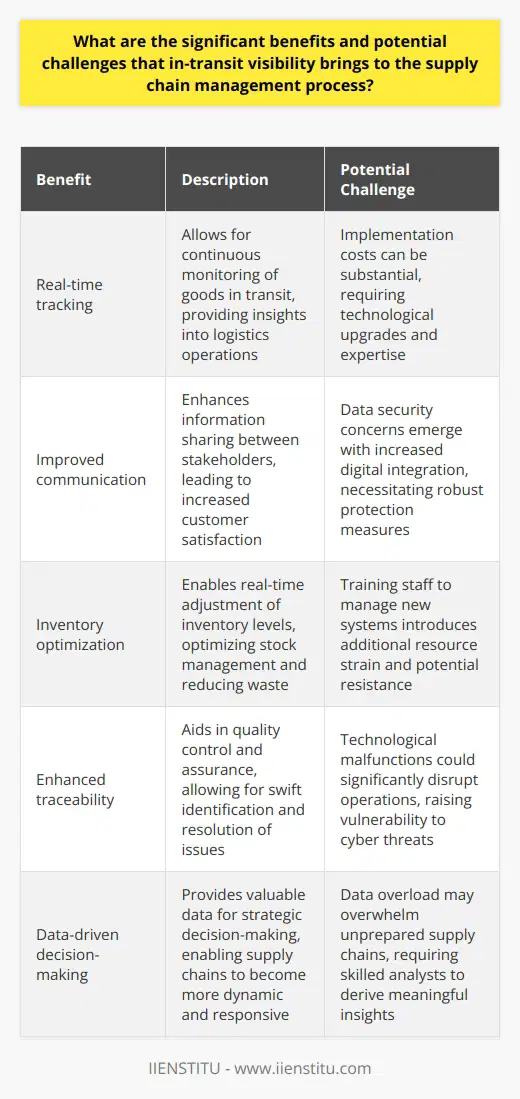
How does in-transit visibility enhance efficiency and reliability within the supply chain?
In-Transit Visibility: Key to Supply Chain Mastery
Supply chains once operated in relative obscurity. Managers lacked real-time data. Today, in-transit visibility changes that landscape. It provides precise information on freight movement. This facilitates proactive management. Enhanced visibility is a game-changer. It offers benefits across several key areas.
Real-Time Tracking Enables Proactive Decision-Making
Real-time tracking stands out. It offers supply chain managers instant data access. This means they can monitor shipments from origin to destination. There are no blind spots anymore. Managers see problems as they arise. This allows for swift, informed decisions. Those decisions prevent delays. They also preserve customer trust.
Integrated Technologies Foster Collaboration
Visibility is not just about location. Modern systems integrate various technologies. RFID, GPS, and IoT are notable examples. These technologies share data seamlessly. Stakeholders along the supply chain reap the benefits. They collaborate more effectively. They optimize routes. They predict arrival times more accurately. Greater cooperation begets greater efficiency.
Inventory Management Becomes More Precise
In-transit visibility affects inventory management. Businesses see exactly where items are. They track quantities on the move. This precision reduces overstocking. It minimizes stockouts. Companies meet customer demands without excess inventory. They balance supply and demand effectively. Working capital improves. So does overall financial health.
Risk Management Improves Dramatically
Risk is inherent in supply chains. Visibility mitigates that risk. Managers anticipate disruptions. They adapt to weather, traffic, or customs delays. They diversify routes when necessary. They avoid potential losses. This adaptability is a boon. Companies that manage risk well gain a competitive edge.
Customer Satisfaction Reaches New Heights
Customers demand transparency. In-transit visibility gives them that. They track orders in real time. Anxiety over late deliveries diminishes. The customer experience improves. Satisfied customers remain loyal. They are likely to recommend the service. This can lead to increased business.
Sustainability Gets a Boost
Sustainability is crucial today. In-transit visibility aids in this pursuit. Efficient routes reduce carbon footprints. Better resource management follows. Companies meet sustainability goals. They lower operational costs. They respond to eco-conscious consumer demands. The environment benefits. The company's public image does, too.
In conclusion, in-transit visibility furnishes supply chains with vital advantages. It transcends traditional tracking. It bolsters decision-making, collaboration, and customer satisfaction. Managers mitigate risks better. They manage inventory with unparalleled precision. Sustainability becomes a tangible goal. All these factors lead to a more reliable, efficient supply chain. It's clear that in-transit visibility is not just beneficial, it's indispensable.
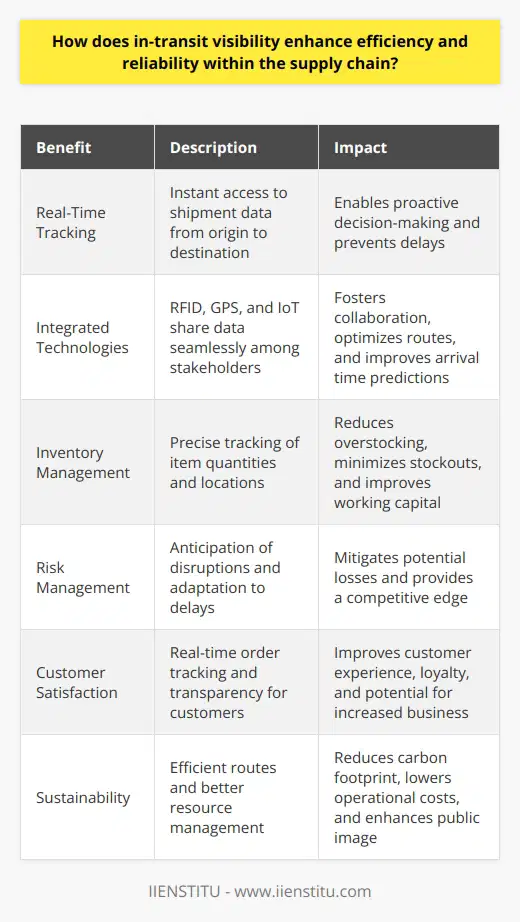
In what ways does in-transit visibility impact inventory management and order fulfillment in supply chain operations?
In-Transit Visibility: Key to Efficient Inventory Management
In-transit visibility represents a pivotal aspect of supply chain operations. It allows for real-time tracking of products as they move from origin to destination. This capability significantly influences inventory management and order fulfillment processes. We will explore these impacts in detail.
Enhanced Decision-Making
Real-time data informs decision-making. Managers gain insights into shipment locations. They can adjust inventory levels accordingly. This prevents overstocking and stockouts. It also ensures efficient resource allocation.
Improved Demand Forecasting
Visibility enhances demand forecasting accuracy. Detailed shipment tracking data reveal transit times. They also show delivery patterns. Companies understand market trends better. They can anticipate demand shifts more effectively.
Reduction in Safety Stocks
Safety stocks act as buffers against unpredictability. Better visibility reduces the need for such buffers. Companies maintain lower safety stock levels. This leads to cost savings. These savings include storage and capital costs.
Streamlined Order Fulfillment
Order fulfillment speeds up with enhanced visibility. Companies track progress in real time. They can update customers promptly. This leads to higher customer satisfaction levels. It also contributes to repeat business and brand loyalty.
Proactive Issue Resolution
Visibility aids in identifying potential delays early. Companies can act before issues escalate. They communicate with suppliers and transportation providers swiftly. This proactive approach mitigates risks. It also maintains supply chain continuity.
Better Supplier Performance Monitoring
Tracking in-transit goods helps assess supplier performance. Shipment data point to delivery timelines. They also highlight reliability and responsiveness. Companies use this information to rate suppliers. It guides future sourcing decisions.
Optimized Transportation Management
Real-time visibility impacts transportation management. Companies adjust routing and modes as needed. They respond to real-time conditions effectively. This optimization reduces transit times. It also lowers transportation costs.
Boosted Inventory Turnover
Effective in-transit visibility boosts inventory turnover. Goods spend less time in limbo. Companies sell stock faster. This increases cash flow. It also signals efficient operations.
In conclusion, in-transit visibility offers manifold benefits. It informs inventory management practices. It also fine-tunes order fulfillment strategies. Supply chains become more resilient. They also operate more effectively. Visibility sits at the heart of successful supply chain management.
